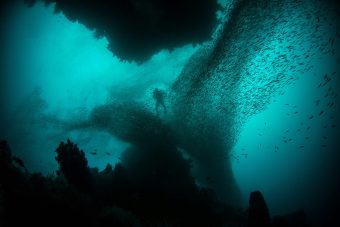The underwater world is constantly alive with sound. The deeper you go, the more light fades, while sound continues its journey through water as vibrations, remaining a reliable guide. In such an environment, acoustics becomes a tool for understanding life beneath the surface. By carefully studying underwater sounds, scientists can track the presence and movements of marine species, as well as the impact of human activity on ecosystems. In the deep, dark, and remote realms of the oceans and seas, vibrations that travel through water – sound – become a vital form of communication. Marine species use it, in tune with their life rhythms, for communication, orientation, and hunting.
A hydrophone is a device that detects sound waves and is used to record and monitor underwater noise. Thanks to these underwater microphones, it is possible, for example, to trace the seasonal migration routes of some marine species. However, this tool also enables us to assess the impact of humans on marine habitats, and one of the current topics in this area is the development of wind farms.
Although wind turbines may appear silent from land as they produce clean, renewable energy, the situation underwater is more complex, as turbines emit low-frequency sounds that travel extensively through the water. One method of detecting their impact is by placing hydrophones near wind farms to analyze changes in the underwater soundscape before, during, and after construction. Based on the collected data, scientists can then determine whether marine species are altering their behavior, ceasing communication, or abandoning the area altogether. Experts believe that each location must be assessed individually, in line with its specific conditions.
During wind farm construction, significant work is carried out on the seabed, from drilling to piling, which causes considerable acoustic stress to marine species. Once construction is complete and the turbine is installed and put into operation, noise in the form of vibrations continues at a lower intensity for as long as the turbine remains active, on average, for more than two decades.
IN FOCUS:
- Sustainable Energy in Practice – First Advanced EV System in Serbia
- YugoHrana – Sharing Empathy and Surplus from the Plate
- Nuclear energy – Risk or pillar of Energy stability?
Sound waves travel faster and farther in water than in air, and fish detect them using, for instance, their inner ear or lateral line, which enables them to sense predators, prey, or other fish. Vibrations caused by construction or other human activity can potentially overlap with the natural signals animals use for survival. According to some analyses, although there is still insufficient data for firm conclusions, wind farms may also have a positive effect by limiting other human activities such as fishing.

In any case, research into the impacts requires specialized equipment that is difficult to obtain, and fieldwork is complex, demanding logistical and technical support that many scientific institutions lack. In such a challenging context, reliable tools become invaluable.
Despite the challenges, there are teams working on developing monitoring instruments. Loggerhead Instruments, a US-based company specializing in advanced acoustic devices, has created a series of acoustic recorders that enable long-term recording and analysis of underwater sounds. The company’s products are used in oceans, lakes, and rivers worldwide to acoustically track and study aquatic life, from marine mammal behavior, migration, and communication, to their reactions to noise and the impact of industrial activity, ship traffic, and the study of underwater soundscapes. These devices operate autonomously and without constant supervision, allowing research in remote marine locations without disturbing the natural environment.
One concrete example, featured on the company’s website, comes from the Pfleger Institute of Environmental Research (PIER) in the United States, where scientists have used Loggerhead equipment for many years to study the white seabass – a species native not to our region, but to the western coasts of the US and Mexico. During spring and early summer, they discovered through recorded sounds that these fish produce specific vocalizations, just after sunset, and during spawning periods. Thanks to this, researchers were able to determine exactly when and where the fish were spawning without capturing or disturbing them, which is vital for conservation efforts.
Prepared by: Milica Vučković
The story was published in Energy portal Magazine PURE ENERGY

